This page contains affiliate links. Meaning, I get a small commission if you purchase through my links, at no extra charge to you. Read the full disclosure here

As an artist, buying the right brushes is an investment.
In order to make this investment and make the process less overwhelming and to help you make the right choices, it’s crucial to know few basic foundational concepts .This will not only help you in making the right decision but also gives you the freedom and flexibility to experiment with various paintbrushes ranging from student grade to professional paintbrushes.
Brushes come in a variety of shapes and sizes under different brands. Sometimes even the experienced artist face decision fatigue in an art shop. So, it’s quite normal to build up a collection of brushes trying to figure out which works best for you.
In this post I will explain what are the different parts of a paint brush and the two types of brushes used in oil painting.
Please note I will be covering only the basic things here that you need to know before making your purchase.
Before we move on, let me explain the different parts of a paint brush.
Different parts of a Paint Brush
Starting with the basics, there are four main parts of a paintbrush: Bristles, Ferrule, Crimp, and Handle.

Bristles
These are the “hairs” that carry the paint. Bristles can be synthetic or natural. Natural bristles are made from animal hair such as hog or sable.
Natural bristles, such as hog hair is durable and stiff and are often used for handling thick oil paints and is ideal for creating textured strokes . Sable hair, on the other hand, is softer and more flexible, providing a smoother application and finer detail.
Synthetic brushes are often made from nylon or polyester filaments. Bristles come in different shapes which determine the type of brush it is.
In other words, Stiff bristles, like those found in hog hair brushes, are excellent for working with thick, heavy paint, allowing for more controlled and expressive strokes where as the softer bristles, such as those in sable brushes, are better suited for blending and smooth applications, providing a more refined finish.
Ferrule
The ferrule is the band that secures the bristles and connects them to the handle and keeps them in shape.
Ferrules are typically made from metal, such as aluminum or brass, and come in various shapes and sizes depending on the type of brush. The metal is usually plated or coated to resist rust and corrosion.
Crimp
Crimp is a part of ferrule where the bristles are secured to the handle. If you look closely at a ferrule you may notice small indentations or ridges that grip the bristles and hold them in place.
The quality of the ferrule determines the quality of the brushes. It is crucial to have proper crimping for the brush’s durability and performance. A well-crimped ferrule ensures that the bristles remain aligned and intact, providing consistent brush strokes and preventing shedding or bristle loss at the time of painting or while cleaning the brushes.
Handle
Handles are commonly made from wood, plastic, or metal. Wooden handles are traditional and often preferred for their natural feel and balance. Plastic handles offer durability and are less prone to wear and tear. Metal handles, while less common, are sometimes used for their strength and modern aesthetic.
Handles come in various shapes and sizes to suit different painting techniques and preferences. Common shapes include round, flat, or well- designed handles that fit comfortably in the hand. The size of the handle can also vary, with longer handles providing more reach and control, while shorter handles offer more precision.
Brushes are named based on their shape, and each shape has a specific use. But what really matters is the bristles—they decide how the brush will perform.
Take a flat brush, for example. Whether it’s made with hog bristles or sable bristles, the shape may look the same, but the way they work is very different. A flat hog brush has stiff, rough bristles that are great for bold strokes, thick paint, and texture. It’s perfect for strong, expressive marks. A flat sable brush, on the other hand, has soft, smooth bristles that create fine details, soft blends, and delicate glazes. It helps refine and smooth out areas of a painting.
So while the shape gives a general idea of how a brush can be used, the bristles decide what it’s truly made for.
Have a look at the image below .
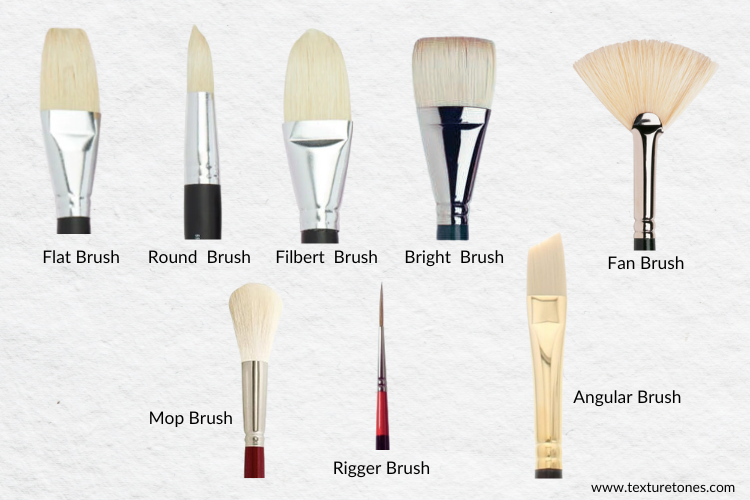
Types of Bristles for oil painting
The two distinctly different types of brushes used for oil painting are Natural hair brushes and Synthetic hair brushes. In oil painting, the choice of bristles can significantly impact the painting experience and the quality of the finished artwork.
Let us understand about what are Natural brushes , the different types of natural brushes and the different shapes of bristles in each of these brushes.
Natural Hair Brushes
Natural bristles are derived from animal hair. They are valued for their unique properties that affect texture, application, and control. Two prominent types of natural bristles used in oil painting are hog bristles and sable bristles.
Each of these are different and are used for different purposes making them suited for different painting techniques and styles.
Hog Bristles
Hog bristles come from the hair of hogs (pigs), particularly the coarse and stiff hairs from the back and legs. These bristles are known for their durability and resilience, making them a popular choice for handling heavy oil paints and creating textured effects.
The coarse nature of hog bristles makes them effective for creating bold, expressive strokes and for painting on rough surfaces. They can also handle abrasive materials and are less prone to damage from frequent use. Hog bristle brushes are highly durable and can withstand rigorous use. This makes them suitable for artists who work with heavy paints or who require brushes that can endure more demanding techniques.
Sable Bristles
Sable bristles are derived from the tail of the sable, a small mammal native to Siberia and northern Asia. Known for their softness and flexibility, sable bristles are prized for their smooth application and precision in detail work.
Sable bristles are soft and flexible, allowing for smooth, even strokes and fine control. This softness is ideal for delicate techniques such as blending and glazing, and it is a perfect choice to achieve subtle color transitions However, they require careful maintenance to preserve their delicate bristles. Proper cleaning and handling are essential to maintain the brush’s performance and longevity.
Different types of Brushes
Flat Brush
A flat brush has a wide, rectangular shape with long or medium bristles, which helps to create bold strokes, sharp edges, and smooth coverage. It holds a generous amount of paint, making it ideal for layering, blocking in shapes, and defining crisp lines. Depending on the angle and pressure applied , the square tip also be used to create precise fine lines.
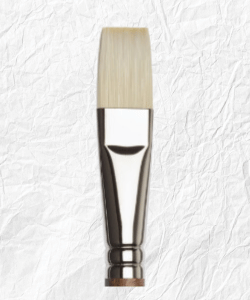
Flat Hog Bristles
A flat hog brush is stiff and strong and are perfect for applying thick layers of paint, by creating bold, textured strokes, and covering large areas. It holds a lot of paint and can be used for both blending with rough, expressive marks.
Best Used For:
- Applying thick layers of paint (great for impasto techniques).
- Creating strong, defined strokes with crisp edges.
- Blocking in colors and covering large areas quickly.
- Scumbling to add texture and depth.
Flat Sable Bristles
Sable bristle brushes are soft and smooth, and ideal for controlled strokes, subtle blending, and glazing. It allows for delicate transitions and fine details, making it perfect for refining edges and achieving a polished finish. Since it doesn’t hold as much paint as a hog brush, it’s best used for thin, precise layers.
Best Used For:
- Blending and soft transitions without visible brushstrokes.
- Glazing and layering thin, transparent paint for depth.
- Refining details and smoothing out previous layers.
- Creating soft edges where a subtle shift in color is needed.
2. Round Brush
These are brushes that has a round, tapered head with a pointed tip. Round brushes are versatile for both detailed work and broader strokes. The pointed tip allows for precise lines and detailed areas, while the rounded shape can cover more surface area.
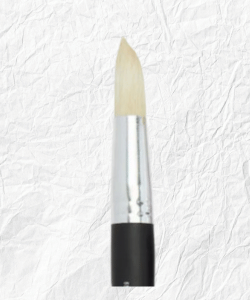
Round Hog Bristles
A round hog brush holds a lot of paint and creates bold, textured strokes. It is not ideal for ultra-fine details but excels at expressive, gestural marks and rough textures.
Best Used For:
- Blocking in forms and sketching rough outlines.
- Creating gestural, loose strokes with visible texture.
- Impasto work, where thick paint is applied for a three-dimensional effect.
- Dry brush techniques for adding broken color and texture.
Round Sable Bristles
A round sable brush glides smoothly over the canvas, making it perfect for fine lines, detailed work, and soft blending. It holds paint well but releases it gradually for controlled application.
Best Used For:
- Fine details like facial features, delicate highlights, and intricate textures.
- Blending and glazing to achieve smooth transitions.
- Thin, controlled lines for decorative or refined work.
- Soft edges where a subtle color shift is needed.
3. Filbert Brush
Filbert brush has a flat, oval-shaped tip with rounded edges, having the versatility of a flat brush and the softness of a round brush. This shape allows for smooth blending, soft edges, and natural-looking strokes without harsh lines. Filbert brushes are often used for creating organic forms, such as skin tones, clouds, and soft textures, making them a favorite for portrait and figurative painting.
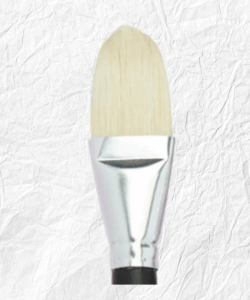
Filbert Brush with Hog Bristles
A hog filbert brush holds thick paint well and provides strong, controlled strokes with a slightly rounded effect. The stiffness allows for layering and creating subtle texture while maintaining a soft edge.
Best Used For:
- Blending while keeping texture, ideal for skin tones and organic surfaces.
- Applying thick paint with softer transitions than a flat brush.
- Creating rounded, organic forms without sharp lines.
Filbert Brush with Sable Bristles
A sable filbert brush is excellent for blending, glazing, and achieving ultra-smooth transitions. The soft bristles allow for delicate, refined strokes, perfect for layering subtle details.
Best Used For:
- Soft blending and smooth transitions, especially in portrait painting.
- Glazing and fine layering to create depth without visible brush marks.
- Refining edges to make them less sharp without losing definition.
- Delicate shading and highlights with controlled application.
4. Bright Brush
A bright brush has a flat, short-bristled shape with a squared-off tip. It is similar to a flat brush but has shorter, stiffer bristles, which allow for more control and precision in applying thick paint. The shorter bristles create crisp, strong strokes with distinct edges, making it ideal for sharp lines, controlled blending, and layering paint without losing structure.
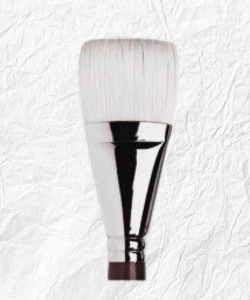
Bright Brush with Hog Bristles
A hog bright brush holds a good amount of thick paint and allows for short, precise strokes. The bristles doesn’t bend too much, making it great for pushing and sculpting the paint on the canvas while maintaining strong edges.
Best Used For:
- Creating sharp, defined strokes with thick paint.
- Layering and building texture without over-blending.
- Blocking in shapes and covering areas with controlled strokes.
- Adding structure and depth to a painting without making it too soft.
Bright Brush with Sable Bristles
A sable bright brush gives more controlled, smooth strokes without harsh texture. It’s best for blending in tight areas and creating refined edges while keeping the application neat.
Best Used For:
- Controlled blending and layering without thick texture.
- Refining details in structured areas, like architecture or facial features.
- Smoothing out transitions while keeping the shape of the brushstroke.
- Adding subtle highlights and finishing touches without overwhelming texture.
5. Angular Hog Brush
An angular brush, also called an angled brush, has a slanted, diagonal tip, which makes it a versatile tool for both broad strokes and precise details. The angled shape allows for sharp, controlled lines while also being useful for blending and covering larger areas. It is particularly helpful for creating dynamic strokes, following curves, and painting at different angles with ease.
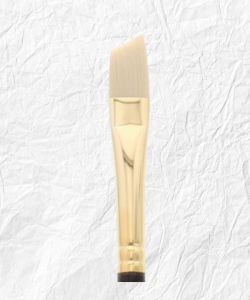
Angular Brush with Hog Bristles
A hog angular brush holds thick paint well and allows for bold, sweeping strokes as well as sharp, defined lines. The stiffness makes it great for textured effects and controlled blending in a more structured way.
Best Used For:
- Creating strong, directional strokes with thick paint.
- Blocking in shapes and filling areas with angled precision.
- Adding texture and rough blending while keeping the strokes defined.
Angular Brush with Sable Bristles
A sable angular brush glides smoothly, allowing for precise, delicate lines and soft blending. The angled tip makes it easy to work in tight corners and refine edges with control.
Best Used For:
- Blending and softening edges with a more precise application.
- Creating fine lines and details in areas that require controlled strokes.
- Shaping curves and contours with fluid, natural transitions.
- Glazing and layering color to add depth without overpowering texture.
6. Fan Brush
A fan brush has a wide, fanned-out shape, making it ideal for soft blending, creating textures, and special effects. It is often used for delicate feathering, subtle transitions, and painting natural elements like grass, foliage, clouds, or hair. The way it performs depends on whether it has hog bristles or sable bristles, each offering different effects in oil painting.
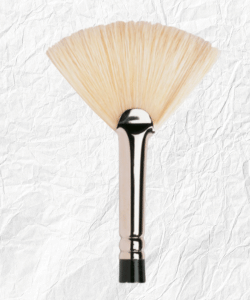
Fan Brush with Hog Bristles
A hog fan brush holds thick paint well and is great for creating textured effects with expressive, broken strokes. The stiff bristles allow for dry brush techniques and adding rough details, especially in landscapes and textured backgrounds.
Best Used For:
- Painting grass, trees, and textured foliage with light, sweeping strokes.
- Creating cloud effects with subtle variations in tone.
- Adding texture to hair or fur in portraits or animals.
- Scumbling and dry brush effects to create depth and movement.
Fan Brush with Sable Bristles
A sable fan brush glides gently across the canvas, making it perfect for blending, softening edges, and creating delicate textures. It does not leave as much texture as a hog fan brush, making it ideal for more refined, subtle work.
Best Used For:
- Blending colors and softening harsh edges in skies, skin tones, and transitions.
- Creating delicate, wispy effects for mist, clouds, or light reflections.
- Glazing to add depth without visible brush marks.
- Gently layering fine details without disturbing the underpainting.
7. Rigger Brush
A rigger brush, also known as a script liner, has long, thin bristles with a fine point, designed for painting long, flowing lines with precision.The long bristles allow for continuous, uninterrupted strokes, making it ideal for delicate details, fine lines, and calligraphic effects in oil painting. The behavior of the brush changes depending on whether it has hog bristles or sable bristles. However if you are looking for high precision and intricate details, I would suggest the sable rigger brush.
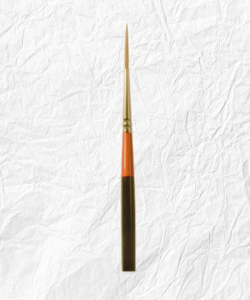
Rigger Brush with Hog Bristles
A hog rigger brush holds thick paint well and is excellent for creating bold, expressive lines with a slight texture. Because hog bristles are less flexible, they create rougher, more painterly lines rather than ultra-fine, smooth details.
Best Used For:
- Drawing bold, textured lines in expressive painting.
- Creating energetic, gestural strokes with visible brushwork.
- Adding fine details with a slight roughness, such as branches or architectural elements.
- Dry brush techniques for a broken, scratchy effect.
Rigger Brush with Sable Bristles
A sable rigger brush glides smoothly, making it perfect for creating precise, controlled lines. It holds oil paint well but releases it gradually, allowing for continuous, flowing strokes without interruption.
Best Used For:
- Painting long, fine lines (e.g., rigging, hair, or delicate branches).
- Adding intricate details with precision and fluidity.
- Calligraphic strokes and signature work on finished paintings.
- Blending in small areas with delicate strokes for soft edges.
8. Mop Brush
A mop brush has a large, rounded, and fluffy shape, designed primarily for blending, softening edges, and glazing in oil painting. It is used to smooth transitions between colors, remove harsh brushstrokes, and create soft, atmospheric effects. Mop brushes are not typically used for heavy paint application but they are excellent at delicate finishing touches and layering subtle tones.
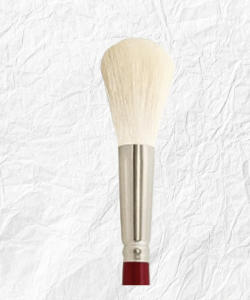
Mop Brush with Hog Bristles
A hog mop brush can blend thick paint but retains some texture, making it great for softening while keeping some painterly strokes. It’s not as soft as a sable mop but is useful when a controlled, semi-blended look is needed.
Best Used For:
- Blending thick paint while maintaining some texture.
- Softening edges without over-smoothing.
- Scumbling to create atmospheric effects with broken color.
- Applying thin layers of paint for depth.
Mop Brush with Sable Bristles
A sable mop brush gently blends and softens paint, creating seamless transitions and delicate shading. It does not leave visible brush marks, making it perfect for refining details and glazing.
Best Used For:
- Blending colors for ultra-smooth transitions.
- Softening harsh brushstrokes without adding texture.
- Glazing to add depth and luminosity.
- Creating misty, soft atmospheric effects.
To conclude, what is the real difference?
Both hog bristles and sable bristles are popular choices for paintbrushes, each offering distinct advantages. Hog bristles are coarse, stiff, and durable, making them ideal for heavy paint applications and textured effects. They are excellent for creating bold strokes and textured surfaces. Sable bristles, on the other hand, are soft, flexible, and resilient, providing superior control and a smooth, refined finish. They are perfect for detailed work, delicate blending, and achieving fine, subtle textures.
What you choose depends on your painting needs. If you are looking for bold strong strokes with texture, you may opt for Hog bristle brushes. On the other hand if you are looking for precision and smoothness choose Sable bristles.
Synthetic Hair Brushes
Synthetic brushes are those where the bristles are made from nylon or polyester filaments. The common name for this filament is “taklon.” Nowadays there are some great high-quality synthetic brushes that mimic natural brushes and are cost-effective. Synthetic brushes are more durable, easier to clean, and are able to withstand harsh chemicals and solvents.
Advantages of Synthetic Brushes
Synthetic brushes offer a range of options for different techniques and applications in oil painting, providing reliable performance and are much more affordable than natural bristle brushes.
Synthetic brushes offer a practical and affordable introduction to oil painting. They are designed to mimic the qualities of natural bristles while providing consistent performance and durability.
As you gain experience and refine your skills, you might choose to explore natural bristle brushes, but starting with synthetic brushes will give you a solid foundation and confidence in your painting journey.
To discover the perfect brush for your artwork, click the link below.
(These are affiliate links, which means that if you click through and make a purchase, I may earn a small commission at no additional cost to you. Using these links is a great way to support my work and help me continue providing helpful content. Whether you’re just starting your art journey or looking to expand your toolkit, these brushes are a solid choice for beginners and beyond. Thank you for your support!)
Additional Reading:
All You Need To Know About Oil Painting Supplies as a Beginner.
Beginners guide: 8 types of brushes used in acrylic painting
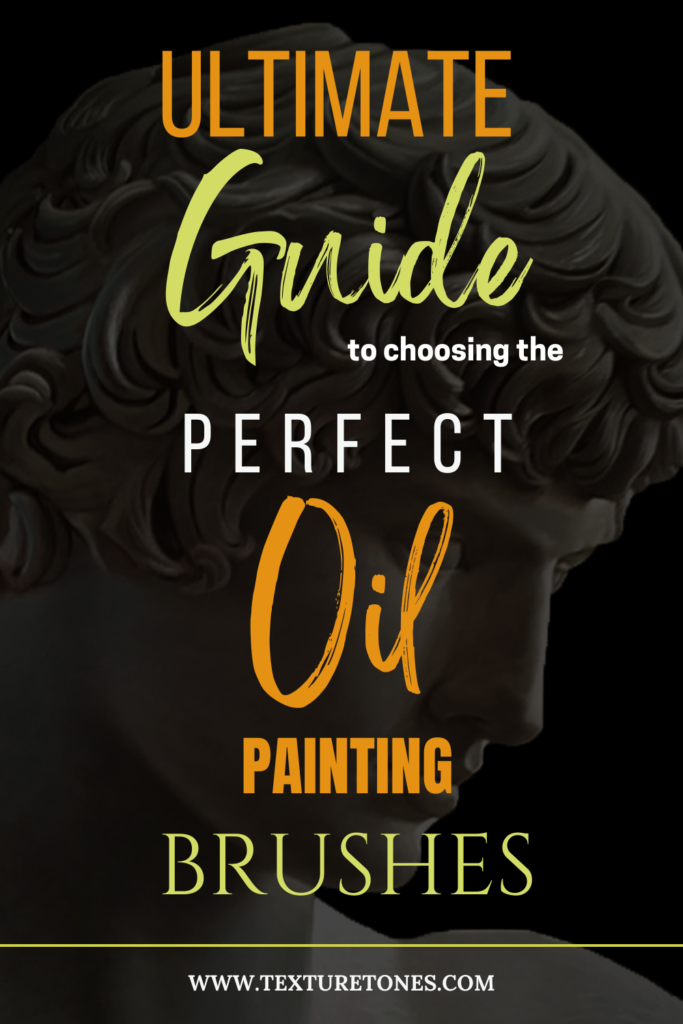


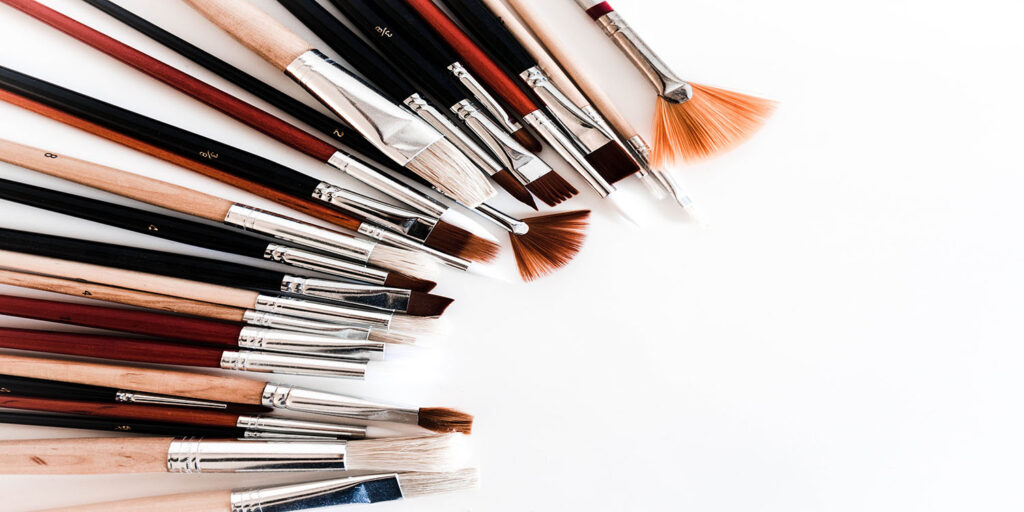
Pingback: All You Need To Know About Oil Painting Supplies as a Beginner. - Art and Design